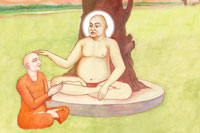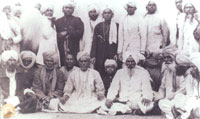Sri Jyoti Nathji was a saint of high calibre. He was an embodiment of saintly virtues. He was pure and transparent - mentally and morally. The town Fatehpur became dignified by the association with such a person. His being extra-ordinary becomes evident by the fact that the liberated soul Sri Amrit Nathji initiated him as his disciple. He was the best, the dearest and the blessed disciple of the Holy Sage. He bestowed his favour on him. He found him endowed with all the qualities which go to make a monk of high order.The holy sage used to describe his qualities in a sentence, "He is an accomplished and a liberated being as a monk, "The scanning eye found that he was the best and the highest of all the mendicants who thronged the monastery.
The statement still reverberates in the precinct of the Ashrama. He was not very keen and enthusiastic about the investiture as the Head of the monastry as a successor of the Late Holy Sage, but he could not refuse the orders of Amrit Nathji Maharaj. He hailed from the state of Haryana. He was born in the year 1964 of the Vikram era. The day of his birth was the eighth day of the bright aspect of the month Margasirsa- corresponding to December of the Western calender. The village of his birth was DANAUDA. From the days of childhood, tendencies of detachment showed up in his heart. He remained unattached, dispassoinate and unconcerned with the worldly ways. Since childhood the spirit of celibacy, restraint, austerity and devotion remained expressed and supreme in his heart. He did not involve himself with marriage and such imbroglios of life as attract the young people naturally and entrap them. He had the highest inspiration of secluded living, completely given to the pursuit of Divine qualities. Day by day, he proceeded gradually and steadily on the path of self-realisation.
The search for the Guru and piercing of the ears :
In the year of 1958 Vikram era he renounced the family of his parents and the bondage of kith and kin. He was in the prime of youth at the peak age of 24 years. The acute longing for an able preceptor took him to various places and people. He roamed from forest to forest and village to village. He had the inspiration for an accomplished Yogic life and in pursuance of the search he set out on journey to holy places. The first meeting with the Holy Sage, Shri Amrtnathji at Churu impressed him immensely. The great sage, too, was immensely impressed by the qualities of modesty, restrained and disciplined speech, simplicity of the heart and the firm and resolute mind regarding celibacy and observance of austerity. Sri Srinathji perceived the broad and gleaming forehead, large and communicating eyes, radiating physique, polite character, fair complexion, imposing personality and the sweet words. Instantly he got convinced that the person deserved to be a monk and was a suitable disciple. Shri Jyoti Nathji also viewed the Holy Sage Shri Amrit Nathji and felt fulfilled. He offered his obeisance at his holy feet. His thirsty heart drank the ambrosia of the devotion to the holy feet of the Guru, to the level of satiation. He offered the wealth of service and faith at the holy feet of the Guru . In the year 1959 of the vikram era he received blessings of Sri Amrit Nathji. He was chosen by him for the service and close association and since then he remained constantly at his feet. The Holy sage was enamored by the extraordinary qualities of his head and heart. Sri Jyoti Nathji felt inspired for the initiation and ear ring ceremony. The longing for the rite was fulfilled in the year 1960 of the Vikram era. In keeping with the norms of the sect he was taken into the fold of the nath Panth - permanently. After the rite, he set out on a journey. In 1961 he roamed the forests and the areas of Rajasthan. In this period he observed the vows of restrained speech & minimal intake. For austerity severity of the apical state and quality of a mendicant he lived on a cremation ground. There he entered into the observance of Sahaja Yoga.
Service to Guruji :
The Holy sage had the inkling of the extraordinary qualities of Shri Jyoti Nathji. He tested him rigorously. He came out of all the tests successful. He became the closest disciple of the Holy Sage.From 1962 to 1968 V.E. he accompanied him on his journeys with an extra ordinary sense of devotion, dedication and selfless service. During this period the Holy Sage gave utmost importance to his service, company and in all engagements concerning daily routine. His cooperation, help, assistance and association were viewed by all with great appreciation.
Building the Monastery :
The Holy sage had the inkling of the extraordinary qualities of Shri Jyoti Nathji. He tested him rigorously. He came out of all the tests successful. He became the closest disciple of the Holy Sage.From 1962 to 1968 V.E. he accompanied him on his journeys with an extra ordinary sense of devotion, dedication and selfless service. During this period the Holy Sage gave utmost importance to his service, company and in all engagements concerning daily routine.
Building the Monastery :
His cooperation, help, assistance and association were viewed by all with great appreciation. All this was done under the direction and supervision of Shri Jyoti Nathaji. Rava Raja Madhav Singh visited the Ashrama in the year 1970 V.E. All arrangements for welcoming him were done by him. The land that Rav Raja had donated to the Ashram is known as "Natha Ji ki Bani". The grandeur, the splendour and beauty that the Asrama commands today are attributed to the concepts and insight of Shri Jyotinathji. He managed the matters and processes with a unique sense of responsibility. The arrangements for welcoming V.I.P. guests and other visitors were flawlessly planned and executed. People hailed him as a dear and blessed disciple of the Holy Sage Sri Amrit Nathji. In the year 1973 V.E. Shri Amrit Nathji Maharaj felt that his time to depart had arrived. He called Jyotinathji near him and put his hand on his head. Everybody who saw this accepted it as a gesture of the announcement of him being the principal disciple of the great sage. He laid to rest in Samathi the sheath, the gross body, of the Guruji and consoled all the people who had gathered on the occassion; he initiated the idea and planned for lighting an eternal lamp in the memory of Guruji at the Ashrama. It is still emitting light. At the great feast known as Brahmpuri he was ordained as the head of the monastery. Honours were showered on him on the occassion. On this occasion he received 51 Bigha land in Udasar for the Ashrama from Sri Caman Singh ji. living were the qualities of his character. He loved to spend his time in a secluded corner of the monastery. He always preferred a thatched hut to a pucca room for living. In the year 1985 he had taken to silence and fasting. He had proved himself an ascetic of few words and few loafs. His countenance and body radiated a unique glow. He constantly gained power and strength. This could be on account of the hidden cataract which flowed in the inner core of his being. This kept his inner and outer aspects flourishing with freshness and lustre. The flowers of his gentle nature kept the environment full of smiles and fragrance of mutual love and care for all. He got many ashramas built at many places and the old walls etc were renovated. He got water huts erected for the people and tanks of water built for animals. He also made arrangements for grains for birds. Swami Ganesh Nathji had established an ashram dedicated to Shri Nathaji at Bisau. Through his disciple. Shri Purna Nathji, Shri Jyoti Nathji got it repaired and renovated in 1955 of the Vikram Era. In the years 1968 to 2004 of the Vikram era, he entered into the practice of SAHAJA YOGA and for this he took to continuous peace and rest. He lied on the bed. He used to take only a porridge of barley. This contained 500 ml of milk and 50 to 60 gms barley granules. He developed a sort of detest for all other meals. Thus, he presented a unique example of abstaining from enjoyment of the subtle pleasure and observing yogic austerity.
The Nath sect bestowed unusual honour on him. In the year 1994 of the Vikram era he was co-ordinated as an honourable member of the managing committee of the All India Avadhuta Yogi Mahasabha, Haridwara. He enjoyed this honour for his whole life. He had intense and deep faith in the teachings and principles of the Nath sect. Therefore he worked sincerely for the propagation of the nath philosophy and ideals of the highest value. He also worked for the extension of Yogic education.
He used to educate the inmates of the Amritshram and exhort them to practise austerity sincerely. He renounced his holy body on the 1st day of the bright aspect of the month Pausa (Corresponding with January). Sage Šubha Natha laid it to rest eternally in Samadhi. All rites were performed according to the canons of the sect. In the year 1974 he got the vertex of the sanctum renovated with white marble. The architecture was designed, executed and completed under the guidance of Sri Jyoti Nathji. Daily worship at the temple was arranged for at the permanent footing by Sri Jyoti Nathji. The main entrance gate to the ashrama and the concrete fencing were erected by him between the years 1975 to 1977. He gave the ashrama the status and character of a neat flawless place of austerity observances. The campus was transformed into a place of spiritual pursuits and penances under his guidance.
The great Amrit Mahotsava :
The devotees and disciples of the Holy Sage wanted to organise a great feast on the days from the 2nd to the 6th of the dark aspect of the month Falguna - corresponding to march. Shri Jyoti Nathji consented. A great congregation consisting of 32 Dhunyas and 60 Mandis witnessed the unification of Mannath Panth. The traces of skirmish arising out of disunity, persisting for long time, were removed forever. The cords of unity and understanding of the Pantha were strengthened.
The great Amrit Mahotsava :
This became possible due to the magnanimity of Shri Jyoti Nathji.Thus dawned a new era in the history of the sect. The sect honoured him with a shawl. He was invested with the status of the PIR the Divine Head of the monastery, Shri Shubha Nathji was acclaimed his successor. The mendicants, Head of monasteries and the populace gathered there for the occassion, felicitated him with tumultuous hail. The Bhandara was a grand sucess because of the calibre, efficiency, spirit of initiation and skillful handling of the situation by Jyotinathji. When the feast and the investure were over he setout on a pilgrimage of the holy places. The programme was an important step towards the accomplishment of the yogic observance. In the year 1984 V.E. he again set out on a pilgrimage. This time the mendicants Shri Krsna Nathji, Baija Nathji, Dwarka Nathji, and Bhani Nathji accompanied him on the pilgrimage. He visited the Hinglaj shrine, Dwarkapuri and other shrines in Gujarat.
His nature, way of living and personality :
Regulated, disciplined and dedicated way of living, restrained food habits and simple
He was a true incarnation and embodiment of The Yogic principles, he was spontaneously joyful and liberated while living and performing all duties.









